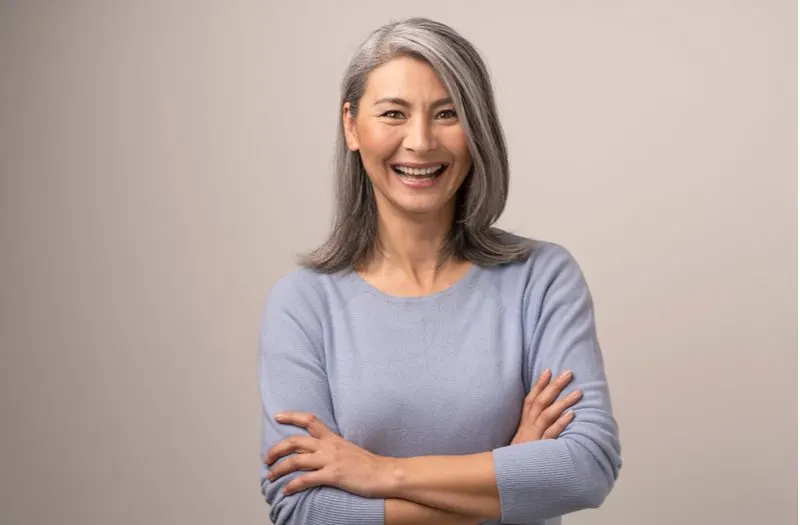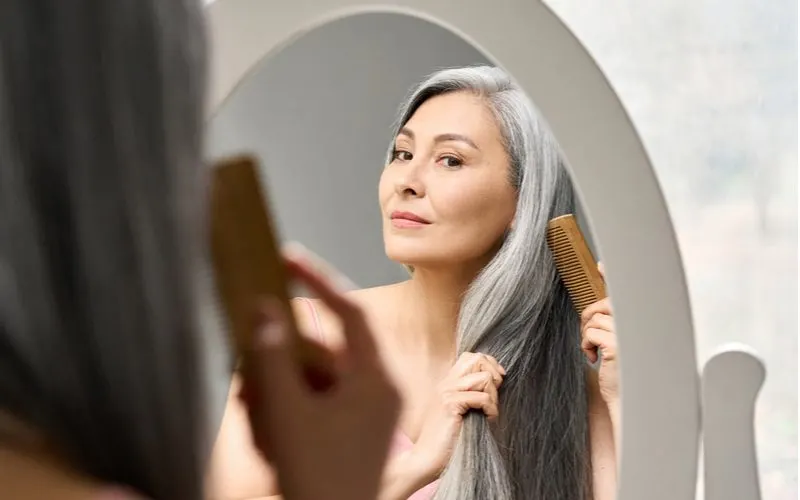Jump to:
If you have been dying your hair for years, you might be a little tired of the constant salon visits, fear of roots, and spending money to color your hair. Ready to transition to gray from lowlights, but don’t want to do it all at once?
Transitioning with lowlights is a great way to gradually bring your hair to a natural, lovely gray. You might be wondering, how do I even do lowlights? Is that the same thing as highlights? Also, how long will it take?
Don’t worry. I’ve got you covered. With this guide, I’ll take you through all the steps to fully transition your hair to its perfect natural shade of gray.
Read Next: What Causes Grey Hair?
How to Transition to Gray Hair With Lowlights

Lipik Stock Media/Shutterstock
Transitioning to gray hair from the dye is a big step. It takes confidence and a certain acceptance of your naturally gray hair. However, you don’t have to do it all at once.
With these steps, you can transition from your colored hair to a completely gray head without making a drastic change or doing it all at once. All you need to do is trust your hairstylist.
A professional will be able to help you make the change with grace and just the right amount of time, over several sessions of lowlights and natural gray coming through.
After a few months, you’ll be ready to say goodbye to the salon and hello to gray hair! The only knowledge you’ll need is what kind of hair and color gray you have, as well as a trusted salon near you.
Otherwise, you just need to take care of your hair at home, listen to your stylist, and prepare to get so many compliments on your new, natural hair color.
How to Transition to Gray Hair in 5 Easy Steps
If you’re ready to leave the dye behind and embrace your natural gray, all you have to do is follow these steps. Once you find a hairstylist that works with you, a gray that matches, and a good schedule, you will be on your way to naturally gray and beautiful hair.
1. Find a Trusted Hairstylist
The first step might seem like a cop-out; is there no way to do this process without a professional hairstylist?
While you technically can dye your hair at home, lowlights are an extremely difficult talent and only professionals have the right tools and equipment to be able to do them correctly. You don’t want to try to give yourself lowlights and end up with poorly bleached, mismatched hair.
The other issue is that you will have to have a personalized tone of gray coloring, and store-bought dyes won’t offer that many options. To achieve a natural, evenly colored tone, find a hairstylist.
A hairstylist will also be able to tell you when to come back for follow-up appointments and recommend personalized hair products.
The internet can tell you a lot, but it will never be able to give you individualized advice about your hair. Finding your hairstylist is a lifelong commitment; they can become close friends as well!
2. Choose the Right Tone of Gray
Not all grays are the same. You might not be surprised by this. After all, there’s a whole grayscale that shades from black to white.
However, what might surprise you is that the wrong shade of gray can clash with your hair and complexion. It’s not a good look, but we’re here to help you avoid it. It’s not just about dark to light, although that does matter.
If you were naturally blonde before going gray, you will probably want a lighter gray to match. Former brunettes might want a darker gray. There are also different types of gray, which depend on your naturally gray hair. Here’s how to tell:
- Naturally white hairs use platinum, silver, or pearl gray dyes
- Naturally gray hairs can match gray, smoke, or lead gray dyes
- Naturally yellow hairs will need green-gray, blue-gray, or violet gray
These colors will help balance out the natural colors in your hair and keep it evenly toned throughout.
Yellower hairs can especially benefit from lowlights, as the blue or violet gray can make them seem silvery. As you transition, you might notice the shades changing. You can always switch lowlight colors.
3. Know Your Hair
Of course, the color gray isn’t the only thing you need to know about your hair. If you’ve been dyeing your hair for years, you might not know exactly how much gray you naturally have.
This will make a big difference in how long the lowlights transition takes before you can go all-natural, fully gray. Finding out how much natural gray you have is usually pretty easy. Wait until your roots are a little visible, and you’ll be able to tell how gray your hair is.
Your stylist will be able to help with this, especially if they’ve been doing your hair for years. For lowlights, the thickness and texture of your hair are also important.
As long as you’ve taken proper care of your hair, a professional stylist will be able to give you excellent results with lowlights. However, if your hair is exceptionally fine, wispy, or brittle, it may be difficult to complete a lot of professional hair care.
4. Figure Out a Maintenance Schedule
All of this information together will help you and your stylist decide when is the best time to come back for a re-toning or to increase your lowlights. It depends on how naturally gray your hair is and how quickly you want to transition.
However, after a while, your lowlights will naturally fade out and your gray hair will shine through. If you aren’t completely gray yet, the process might take some more time.
You will have to continue renewing the lowlights for a while because otherwise your darker, non-gray roots will come through and be visible. Most commonly, you’ll need to go in for maintenance every other month or so.
This way, you can maintain a natural amount of lowlights, check on the color of your graying hair, and watch the gradual transition to a completely gray head of hair. Ask your stylist for details; they’ll know your hair better than anyone else!
5. Take Care of Your Hair at Home
Between salon visits, you must take proper care of your hair. Gray hairs are coarser than younger hairs, and you should use age-appropriate shampoo, conditioner, and other products.
Your salon can recommend products to keep your hair smooth and healthy throughout the weeks. One of the most common products is a blue or purple shampoo. Depending on your hair tone, you will use the color to balance out the “sour” opposite–orange or yellow tones in your hair.
Using purple shampoo once a week will keep your hair from getting that brassy look you might not want. Instead, you’ll stay glossy and hydrated throughout.
Of course, you should always hydrate your hair as well as you can. Get a color-saving, deep conditioner that will keep your hair from drying out, especially with the excess product you’re using to keep it glossy and gray.
Frequently Asked Questions

insta_photos/Shutterstock
If you are still wondering about some of the details of converting into gray hair with lowlights, look through some of these questions. They are commonly asked, and the answers might help you on your hair journey!
How Long Will it Take to Transition to Gray?
The transition from colored hair to gray hair depends on many factors but can take anywhere from six to twelve months. This depends on the length of your hair, the original color, its thickness, and which lowlights you choose.
To make this transition go faster without it being a drastic change, you can focus on taking good care of your hair at home. With excellent hair care, your hair will grow quicker and your stylist will be able to help you complete the transition.
Can I Give Myself Lowlights at Home?
While an experienced self-hair stylist will be able to dye their hair, highlights and lowlights are much more difficult. Highlights use layers of foil on the top of the hair to create a different color.
Lowlights, on the other hand, involve a cap with multiple holes for small strands of hair to come through. The technique, tools, and salon-level coloring you would need to do lowlights at home are incredibly hard to come by.
They are easy to make mistakes on and difficult to fix. If you value your hair color and time, just go to a salon and let a professional take care of your lowlights for you.
What is the Difference Between Highlights and Lowlights?
Highlights add light to the hair. To give highlights, a hairstylist will wrap sections of your hair in a lightening agent and foil, as well as the proper color of hair dye.
Highlights bring out the lighter colors in your hair and increase the volume of color. Lowlights, on the other hand, bring out darker colors in your hair. Without the contrast between dark and light, the highlights and in-between colors wouldn’t look as full.
Lowlights to transition are much more common than highlights because they offer a subtler way to make the change.
Is Gray Hair in Fashion?
Gray hair is in fashion, both for younger and older folks. Young people are dying their hair white, silver, and platinum and using highlights to transition or add more color.
It’s more than just a fashion trend, however; people have been doing this for decades and appreciating the beauty in silver hair. It’s also coming back into style to go gray naturally instead of dying hair.
Many celebrities have embraced their natural gray hair, and ordinary people are following suit. As society moves away from anti-aging and fully accepts gray hair, you can join them and let your natural colors shine through.
Should I Dye My Hair Gray?
If you are graying naturally, there’s no need to find a gray hair dye and fully dye your hair. Odds are, the grays won’t match, and your roots will show through anyway.
Instead of doing a drastic change like this, consider a gradual shift with lowlights and or highlights. They will ease you into a salon-free, fully gray life. However, if you are not naturally gray and want to try it out, there are plenty of options for you.
You won’t have to worry about matching colors and can pick your favorite shade of gray. When you dye your hair, you can do it gradually with lowlights or all at once. Have fun with your hair–it will always grow back!
So, How Do You Transition to Gray Hair with Lowlights?
To fully transition to gray hair with lowlights, you’ll need a trusted hairstylist. However, you can do it gradually and gracefully by choosing the right gray, knowing your hair, and taking care of it well at home. You’ll be fully gray and gorgeous before you know it!
